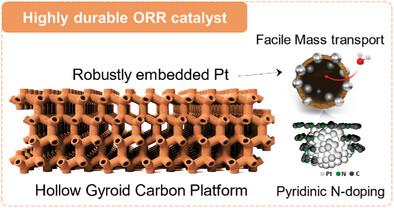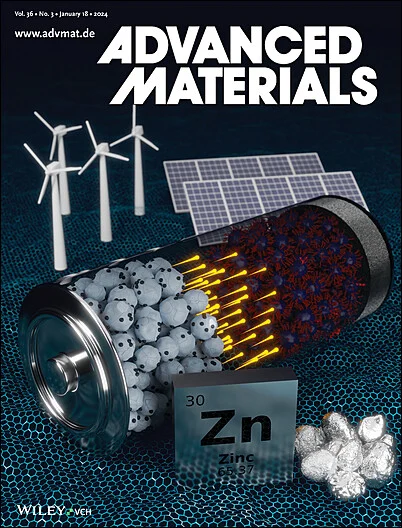具有双连续中间结构的自组装空心陀螺:高度稳健的电催化剂固定平台
IF 27.4
1区 材料科学
Q1 CHEMISTRY, MULTIDISCIPLINARY
引用次数: 0
摘要
商用质子交换膜燃料电池(PEMFC)中 Pt/C 的电化学降解是限制其耐用性和性能的一大挑战。这种降解主要源于碳腐蚀,碳腐蚀会导致与催化剂载体结合力较弱的电催化剂颗粒脱离。本文报告了异常坚固的空心陀螺状形态,其设计目的是在氧还原反应(ORR)中实现强力的电催化剂固定和广泛的表面可及性。为了利用聚(苯乙烯-b-2-乙烯基吡啶)(PS-b-P2VP)嵌段共聚物获得自组装陀螺状纳米结构,使用了对 P2VP 嵌段具有高选择性的二甲基甲酰胺进行溶剂蒸汽处理。研究发现,在碳化之前在形成陀螺的 P2VP 微域中保留残留溶剂对于形成内嵌电催化剂的空心陀螺至关重要。与实心陀螺碳(SGC)相比,这些空心陀螺碳-铂(HGC-Pt)纳米结构的电化学活性表面积增加了 3.6 倍。根据系统分析,这种优异的电化学稳定性归因于空心几何形状大大提高的表面可及性、均匀而坚固的催化剂嵌入以及来自 P2VP 嵌段的大量吡啶氮掺杂。本文章由计算机程序翻译,如有差异,请以英文原文为准。

Self-Assembled Hollow Gyroids with Bicontinuous Mesostructures: A Highly Robust Electrocatalyst Fixation Platform
The electrochemical degradation of Pt/C in commercial proton exchange membrane fuel cells (PEMFCs) is a major challenge that limits their durability and performance. This degradation mainly arises from carbon corrosion, which facilitates the detachment of electrocatalyst particles that are weakly bound to catalyst supports. Herein, unusually robust hollow gyroid morphologies designed for strong electrocatalyst fixation and extensive surface accessibility during oxygen reduction reactions (ORR) are reported. To obtain self-assembled gyroid nanostructures using a poly(styrene-b-2-vinylpyridine) (PS-b-P2VP) block copolymer, a solvent vapour treatment with dimethylformamide, which is highly selective for the P2VP block, is applied. It is discovered that retaining residual solvent in the gyroid-forming P2VP microdomain before carbonization is crucial for forming hollow gyroids with embedded electrocatalysts. These hollow gyroid carbon-Pt (HGC-Pt) nanostructures exhibit a 3.6-fold enhancement in electrochemically active surface area compared to solid gyroid carbon (SGC) counterparts. Based on systematic analyses, this exceptional electrochemical stability is attributed to greatly enhanced surface accessibility derived from the hollow geometry, uniform and robust catalyst embedding, and extensive pyridinic nitrogen doping from the P2VP block.
求助全文
通过发布文献求助,成功后即可免费获取论文全文。
去求助
来源期刊

Advanced Materials
工程技术-材料科学:综合
CiteScore
43.00
自引率
4.10%
发文量
2182
审稿时长
2 months
期刊介绍:
Advanced Materials, one of the world's most prestigious journals and the foundation of the Advanced portfolio, is the home of choice for best-in-class materials science for more than 30 years. Following this fast-growing and interdisciplinary field, we are considering and publishing the most important discoveries on any and all materials from materials scientists, chemists, physicists, engineers as well as health and life scientists and bringing you the latest results and trends in modern materials-related research every week.
 求助内容:
求助内容: 应助结果提醒方式:
应助结果提醒方式:


